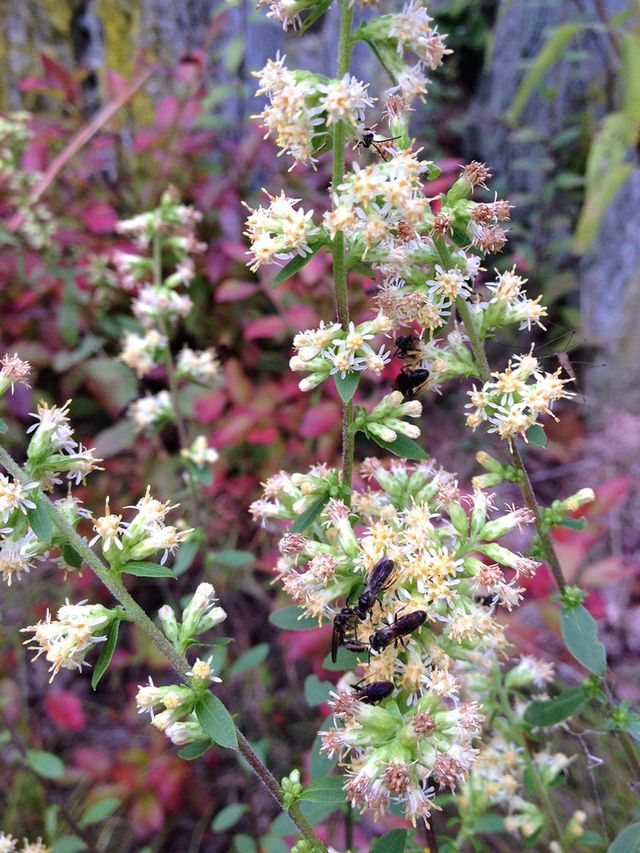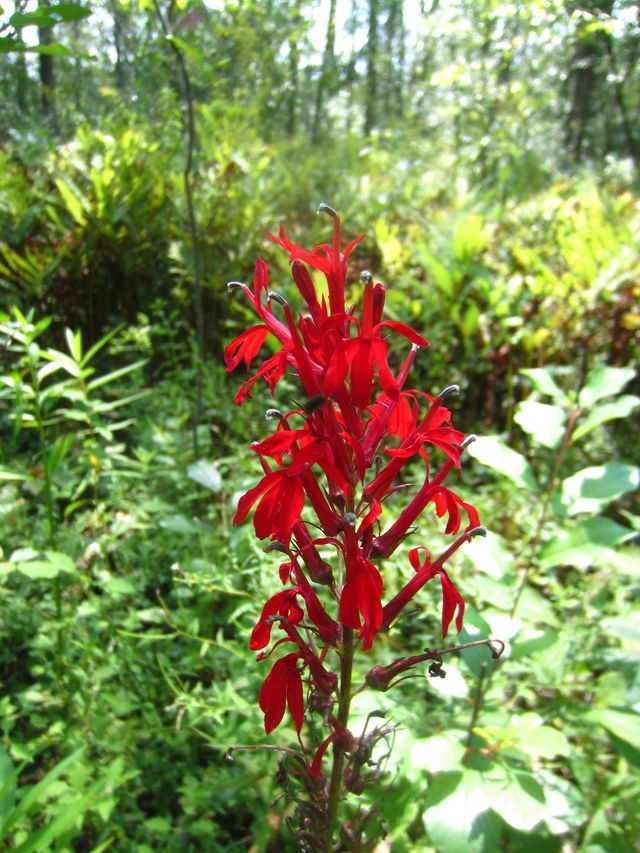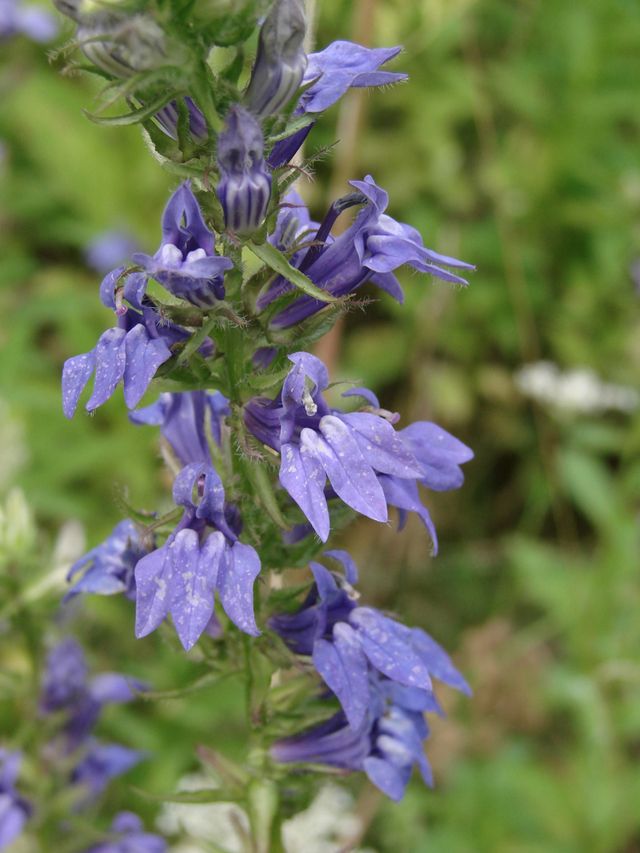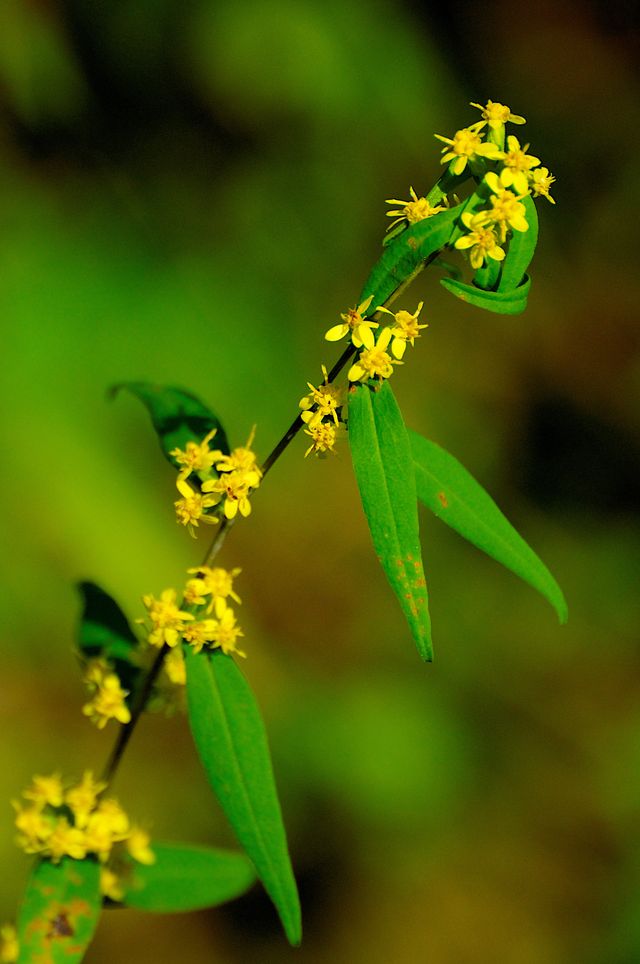

Autumn is an ideal time to add native plants to your garden that are popular with pollinators. Cooler temperatures, warm soil, less water stress and limited weed competition encourage strong root growth. Douglas W. Tallamy, American entomologist, ecologist, conservationist and author, explains “ . . . we humans have disrupted natural habitats in so many places that the future of our nation’s biodiversity is dim unless we start to share the places in which we live . . . with the plants and animals that evolved there.” Tallamy stresses, “Our success is up to each one of us individually. We can each make a measurable difference almost immediately by planting a native nearby. As gardeners and stewards of our land, we have never been so empowered—and the ecological stakes have never been so high.”
With more than fifteen native goldenrod (Solidago) species populating Western New York counties, planting options are mind-boggling! The forest goldenrod (Solidago arguta) is a clumping perennial that grows two to three feet tall in medium to dry soil. It spreads by seed, not rhizomes. Forest goldenrod blooms beautifully in full shade, providing nectar for woodland insects in the fall when many other plants have already stopped blooming.
White goldenrod (Solidago bicolor) is a clumping, herbaceous perennial that grows well in dry (often poor) soil in full sun to partial shade. It seems to prefer soil with a heavy clay content and tolerates drought. White, bell-shaped blossoms climb the elongated stem in a spiral formation. The flowers attract butterflies and bees in late summer and birds love the seeds. The sap of the goldenrod is toxic, so deer and rabbits avoid this plant. White goldenrod is the only species of solidago found on the east coast with white rays. It is easy to grow, low maintenance, and trouble-free.
The slender, purplish, arching stems of blue-stemmed goldenrod (Solidago caesia var. caesia) grow one to two feet tall. Both branched and unbranched stems display scattered clusters of yellow flowers. The large terminal cluster is composed of arching sprays of tiny golden blooms. It is shade tolerant, grows in dry soil, and is not aggressive, spreading slowly by underground creeping rhizomes or by seed. The blue-stemmed goldenrod is a magnet for butterflies, moths, bees, wasps and beetles.
Within the Campanulaceae family of more than 400 species of lobelia, several are native to Western New York. The cardinal flower (Lobelia cardinalis) produces an erect inflorescence about 28″ tall bearing vibrant red flowers during the summer and fall. Its overall height is four feet and it prefers moist to saturated soils. Two additional native lobelia species include Indian tobacco (Lobelia inflata) and the great blue lobelia (Lobelia siphilitica). All three plants display the typical “lip” petal near the opening of the flower, which is common to the genus. They also produce a milky sap containing latex, which oozes out when the plant is cut or bruised. The latex is a crucial part of the plant’s defense mechanism against herbivores and pathogens.
Indian tobacco (Lobelia inflata) is an annual with small, pale lilac-colored flowers and tiny white dots along the leaf margins. It grows from six to thirty inches tall in full to part sun in moist soil but will also grow in gravel and poor soils. Indian tobacco does not mind competition from other plants so it will intermingle happily in existing gardens. It attracts small bees while deer sidestep it due to its high toxicity to mammals.
The great blue lobelia has violet-blue flowers and is pollinated by bees whereas the cardinal flower is primarily pollinated by the ruby-throated hummingbird. This is the only breeding hummingbird species found in New York State.

JUST CHILLING . . .
Many pollinators hibernate during the winter by pausing their development and hunkering down until spring. This state of dormancy is defined as diapause. During this hiatus, incredible protective strategies are activated to help the insects survive in extreme conditions. Adding more pollinator habitat is key in winter.
Small carpenter bees, mason bees, yellow-faced and leaf cutter bees carve out their nests inside dry, hollow stems and spend the winter under cover. Leaf piles are essential shelters for hibernating bumblebee queens and the larva of numerous moth and butterfly species. Mulch attracts beneficial insects like lady beetles who are ready to attack pesky aphids once spring arrives.
Native bees, including mining bees and bumble bees, overwinter as larva by tunneling deep into the ground. Dragonflies, in nymph form, overwinter beneath the ice. Predatory beetles such as tiger beetles remain mostly dormant inside and under old logs. Praying mantises survive the winter by laying eggs on a vertical surface such as a plant stem, rocks or fence post. Firefly larvae like to overwinter in decaying pine logs, at the base of trees or underneath loose bark.
THE ROLE OF NATIVE PLANTS IN THE WINTER GARDEN
Since native grasses have a long growing season and retain their structure through winter, they can provide four seasons of resources and habitat for pollinators and other wildlife. Their extensive root systems (measured in feet) help store carbon in the soil, impede stormwater and reduce erosion thus boosting their ecological value.
In the Poaceae family, switchgrass (Panicum virgatum) is a larval host plant for moths and butterflies. It is a long-lived perennial that grows two to five feet tall and spreads slowly by short rhizomes. The seed plumes linger well into winter, providing food for songbirds. Little bluestem (Schizachyrium scoparium) produces silvery-blue shoots in spring with the blades turning a dazzling reddish-tan in the autumn. It grows best in full sun. The fuzzy white seeds are beneficial to small birds in winter.
Yellow indian grass (Sorghastrum nutans) is a showy, tall perennial with soft, plume-like, golden seed heads. Broad blue-green blades stay low most of the year, then grow three to eight feet tall before blooming in early autumn. This bunching grass develops rich gold and purple seeds and panicles and deep orange to purple blades. Yellow Indian grass will grow in sun or shade and dry or moist soil and is drought tolerant. Granivorous birds eat the seeds and use the leaf blades for nesting material. It is the larva host for the Pepper and Salt Skipper butterflies.

WHAT ABOUT THE BIRDS?
Many birds overwinter in Western New York, including the black-capped chickadee, the northern cardinal, the tufted titmouse, the downey and pileated woodpecker, and the barn owl. Grasses provide birds with seeds, nesting materials and shelter.
“Birds are the lynchpin of every garden,” explains Monty Don, British horticulturist, broadcaster, and writer. “The more birds you have, the more snails and slugs get eaten.” Birds are important members of the food chain, providing natural control of mosquitoes, Japanese beetles, whitefly, scale insects, and aphids.
This fall and winter, invite pollinators to your garden by planting just one fall-blooming native or an ornamental grass with attractive seedheads for the birds to nibble on. Support insects, reptiles, birds, and small mammals by creating an environment rich in habitats using leaf litter, logs, branches, and mulch. Install nesting boxes, birdhouses, and feeders to enjoy the winter activities of wildlife. You and your garden can make a difference!
USEFUL RESOURCES FOR NATIVE PLANT RESEARCH
Bringing Nature Home by Douglas W. Tallamy Audio and Ebook available on Hoopla
The Northeast Native Plant Primer by Uli Lorimer Ebook available on Hoopla
Native Plant Gardening for Birds, Bees & Butterflies: Northeast by Jaret C. Daniels Ebook available on Hoopla
New York Flora Atlas: newyork.plantatlas.usf.edu
Colleen O’Neill Nice is a horticulturalist who is passionate about plant propagation and enjoys nurturing her garden in Clarence, New York.
This article originally appeared in the September/October 2025 issue of Upstate Gardeners’ Journal.
Views: 64




